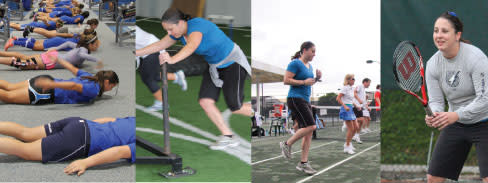Upping My Game
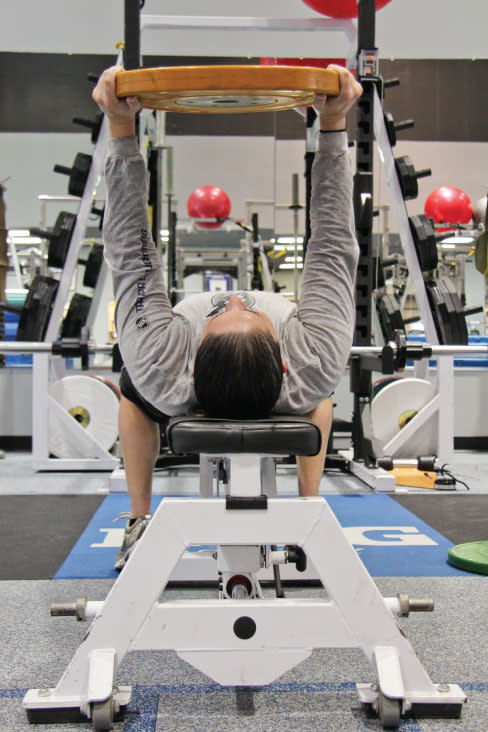
It was 2:30 in the afternoon, and running 40 yards never seemed so impossible. But my oxygen-deprived brain told me I didn't have a choice. Out of breath and dripping sweat, I braced myself against the steel "sled," dug my toes into the Astroturf and set off for one more leg-killing, lung-burning 40-yard push.
When I made it to the end, I sat down right there on the line, looking up at the IMG strength and conditioning coach who had just ordered me through an hour of torturous exertion that ended with the dreaded sled push. "Thanks," I wheezed. "That was awesome."
There's fit, and then there's fit. At 33, I'm well removed from my days as a Division I college soccer player, but my concept of "fitness" goes beyond the gym and a jog. I still play soccer, and now ice hockey, too, and other sports in between, from boxing to beach volleyball. Being healthy isn't enough; I exercise for performance.
But in the one-size-fits-all world of adult recreational fitness, where any exercise is good exercise, it can be hard to get better when you're doing pretty well already. So what do the fit do in Sarasota when they want to get fitter? It turns out we have some excellent resources for athletes who want to get to the next level. I set out to experience a few.
My adventure started at HealthFit, Sarasota Memorial Health Care System's 45,000-square-foot Clark Road compound for medically integrated fitness. In addition to rehabilitation and medical offices, HealthFit is a membership-based gym facility with, among other things, basketball courts, a lap pool, fitness class studios, racquetball courts and a sprawling cardio- and weight-machine room. And, thanks to the facility's medical equipment and experts, it's a great place to pinpoint my current health and fitness stats. Without specific, scientific measurements, exercise can be frustratingly vague and even counterproductive.
HealthFit fitness supervisor Doug Sham spent an hour measuring and testing me: 5 feet 8 inches tall, 166 pounds, blood pressure 120/68. My body-mass index (BMI), measured with a handheld "bioelectrical impedance analysis" device instead of the standard (but misleading) height-to-weight ratio, was 25.2—technically overweight, although just barely. Oy. I'd hoped muscle mass accounted for more of my weight. "OK, so obviously I want to reduce body fat," I told Sham, who suggested I aim for a reasonable 155 pounds and a BMI of 23. Besides, losing fat would help with my other goals, like increased speed and agility.
But let's face it, a lot of laypeople don't know how to target fat loss while still maintaining athletic performance. This is where the "VO2 max" test came in. At HealthFit, I jogged on a treadmill while wearing a heart-rate monitor and a big plastic face mask attached by tubes to a machine that measured my oxygen consumption. I might have felt silly if I weren't pretending I was in a Gatorade commercial. The test revealed how many calories I burned at certain heart rates as well as my aerobic and anaerobic heart rate thresholds—info Sham used to design a treadmill routine that balanced fat-burning workouts with performance-maintaining anaerobic workouts.
A recurring theme during my quest for improvement would become "exercise variation," and after giving me a weekly hockey-specific exercise program (to accompany my treadmill routine), Sham recommended I try Pilates. "What happens with most athletes," HealthFit Pilates director Nina Desloge told me, "is that they develop very specific muscles related to their sport, which can create an imbalance in opposing muscle groups."
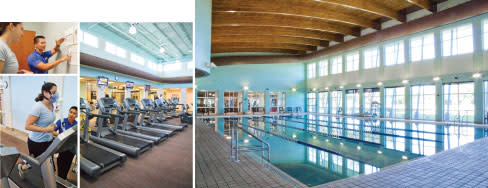
Sure enough, Desloge put me through an hour-long workout on a Pilates "Reformer" machine, charitably telling me, "The fact that you're an athlete with a significant amount of body awareness really helps you pick up the exercises very quickly." I did not see evidence of this athleticism in the mirror as I struggled to flex and point and perform the exercises smoothly, but I appreciated her attitude. (Added bonus: I was thinking so hard I didn't realize I was exercising.) At the end, I wasn't sure: Where was the fall-down fatigue and breathlessness I expected from a workout? Where was the sweat?
The next morning, I reached for the cereal and felt strange soreness in what I can only describe as "the back of my armpit." Each subsequent movement revealed evidence of muscles unseen and oft-underworked—the outside of my hips, the lower outside of my abs. Lesson learned: Achieving the next level often requires expert targeting rather than an all-out frenzy of exertion.
Among the weaknesses Pilates exposed, my core stood out. During one exercise, as I sat straight up and then tried to lean straight back to not even a 45-degree angle, my whole upper body shook. It was pretty embarrassing.
It turns out, core strength is a big issue—especially for people who spend long periods of the day in office chairs, according to Mike Gough, owner of Lakewood Ranch's Athletic Edge Sports. "People may want one thing," says Gough, "but they need to improve a couple of other things first. We have to look at the foundation."
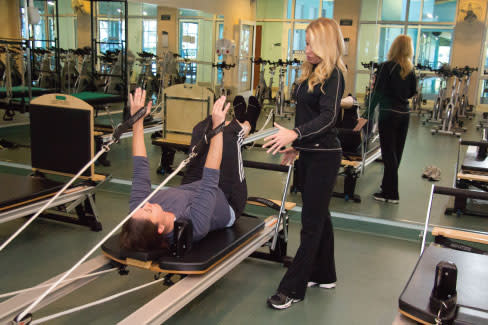
Gough, whose friendly Canadian accent helps soften his football-player size, has spent his career training professional athletes. Autographed jerseys of NFL stars like Victor Cruz and Joseph Addai hang on the walls of his 8,500-square-foot facility on Lakewood Ranch's Main Street. But recently, Gough opened up his business to executives in search of a more competitive fitness program. "Busy professionals are just like athletes," he says. "They're eating out a lot, they travel—they have a demanding schedule."
Motivation, he argues, is not lacking: "You'd be surprised. These people want somebody to push them."
The warm-up focused on dynamic stretching—controlled, range-of-motion movements like high kicks and lunge-twists. When I lay on my stomach and attempted to stretch my hip flexor by pulling my foot toward the back of my head, the absence of flexibility elicited a "Wow" from Gough.
Without a full range of motion, it's impossible to work all of the surrounding muscles. And inevitably, the hip flexors and the muscles around them, which are responsible for much of the body's stabilization, are Gough's initial focus.
"People do a bunch of bench presses and think that's a workout," he says. "They focus on the areas they want to look good." Hip flexors tend not to be an aesthetic priority.
Athletic Edge has a number of state-of-the-art exercise machines, including air-powered "weights" that provide equal resistance through the entire lifting motion, as well as a treadmill that measures the force exerted by each stride. But Gough put me through a series of simple exercises using just a rubber exercise band encircling my legs above the knee—squats and crab walks, for example—plus a few one-legged balance and strength exercises and some equipment-less ab work, like crunches and planks. The results? Burning and fatigue, seemingly centered on my belly button and radiating outward. It would take a few weeks at least, he admitted, before my foundation could catch up to the rest of my body so we could work on more sport-specific exercises and speed, but it would be worth the wait. "When you provide structure, you get results quick," he says.
Structure—that's the key, I learned. Adult fitness is often rudderless and haphazard. Improvement is more likely with one-on-one assessments and personalized guidance. Especially for those who are already fit, it's not always the will to exercise that foils our fitness, but the content of the workout.
With that in mind, I turned to Patricia King, licensed dietitian and nutritionist for Kaizen Total Wellness, a program founded by local physician Dr. Harvey Mishner for medical- and lifestyle-based wellness. I had been aiming for three balanced meals a day, with healthy snacks in between. But based on my activity level, King, who emphasizes blood sugar stabilization instead of pure calorie counting, recommended I increase the frequency of meals, eating every two to three hours to make sure my blood sugar never dipped too low. Each meal needs a balance of complex carbs, proteins and good fats—"They all work together," she says. "For a lot of people getting that protein in is an issue." When exercise causes a dip in blood sugar, reach for protein-rich nut butters or protein bars to equalize levels.
In fact, there's no real trick to a good fitness diet beyond what would be a good diet for most people. We fitness buffs get ourselves amped up thinking we need food or drink to provide a "burst" of energy, when chances are our body already has all the tools it needs to get us through—and if it doesn't, no amount of last-minute sustenance can make up the difference.
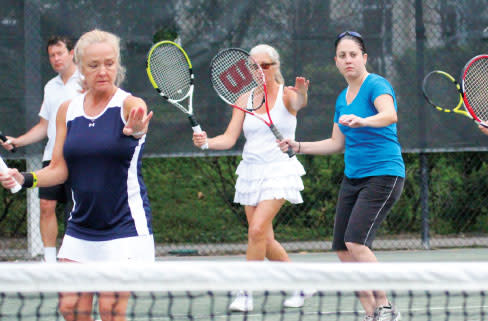
Recreational athletes can make dramatic nutritional decisions that are, at best, unnecessary and, at worse, counterproductive. Sports drinks, for instance, shouldn't come into play unless you're sweating for a half an hour or more. "Carb loading," eating a massive amount of carbohydrates to fuel an upcoming workout, is only helpful if you plan to be working for upwards of an hour and a half, says King. And even then, carb loading doesn't mean eating a pasta dish a few hours before your event, or even the night before. "A week before would be a good rule of thumb," she says. Then, your meals should be 50 percent complex carbohydrates, moving up to 70 percent three days before.
But hydration is one thing we should take seriously. I was starting to think cramping was an inevitable part of my workouts; my hamstrings alone had almost cut short my Pilates hour. Coffee, I was told repeatedly, was a big culprit in dehydration. Also, King recommends always having a bottle of water on hand during a workout. "For the amount you're exercising," she told me, "keep a cooler full."
Playing a sport badly can still be good exercise, but playing well provides the motivation to keep it up: fitness as a byproduct of fun.
Bradenton's IMG Academy has an international reputation as an elite, hardcore fitness destination where many of the world's best athletes go to get better—including tennis' Williams sisters, NFLers like Drew Brees and Cam Newton, and the U.S. women's national soccer team. Among its adult amateur programs, IMG serves up that competitive edge in the form of rigorous three- and five-day camps for golf, tennis, or just overall strength, conditioning and performance.
I showed up on a set of IMG clay tennis courts at 8 a.m., joining a dozen or more men and women of all ages and shapes. The group-training atmosphere was refreshingly earnest. While the coaches joked and encouraged, they didn't coddle. As I got lazy into the 10th, 11th and 12th repetitions of a footwork drill, my coach repeatedly called me out, pushing me to sidestep to the cone, hustle forward to the ball and back to the cone.
One at a time, each easy-to-implement instruction from the coaches changed my game: Turn your left toe forward; shorten your back swing; after you hit the ball, touch the racquet with your left hand; step forward with your right foot on the follow-through. Tennis isn't even among the sports I play regularly, but I began to believe it could be—and be just as challenging and rewarding as an hour on the ice or 90 minutes on the pitch.
After three and a half hours, I felt fatigued but energized, eager to play more, to get even better. It's a truly brilliant workout that leaves you both exhausted and excited for the next one.
But after lunch, instead of continuing on with the tennis program, I had scheduled an abbreviated afternoon with the adult performance camp. While all the adult programs have access to weight training, mental conditioning and other of IMG's athlete resources, the performance camp puts everything together for a total immersion in fitness, including high-intensity strength and conditioning workouts designed to target—some would say "torture"—the whole body.
I had at this point not started following King's nutritional advice—I hadn't been balancing my meals with the right amount of protein and complex carbs, I had skipped breakfast, and the pasta I had from IMG's lunch buffet wasn't going to help. Despite my enthusiasm, after nearly four hours of exercise earlier in the day, I knew I was in trouble the moment I picked up the little two-pound dumbbells for a shadowboxing warm-up.
I pushed through. That's what athletes do, right? I didn't have the energy to be embarrassed, but I began failing at exercises—unable to complete squats during a circuit; requiring the coach's assistance during pull-ups; falling behind on the battle ropes. By the time we got to pushing the weighted sled on the turf outside IMG's primary strength training gym, I knew I was being pushed harder than I had been in nearly a decade.
But as soon as I got to the finish line and the coach said, "That's it! Good job," I also felt more relief and satisfaction than I had since having my college soccer coach congratulate me on the last afternoon of an exhausting preseason.
That outsider-designated end point is another valuable training tool that's often overlooked in our adult lives. It can make the difference between training and overtraining; between knowing you've accomplished something and wondering if you should have tried harder. As helpful as it is to have someone there to push you, at a certain level of fitness and motivation, it's also important to have someone there to say, "You're done."
And at that point, for all my enthusiasm and pride, I was done. I really, really was.
To follow Hannah's progress on her quest for super-fitness, read her weekly blog, The Health Report, at sarasotamagazine.com.
Truth in Exercise
New medical studies reveal some surprising facts about fitness.
Stretching Before Your Workout Can Be Bad
Static stretching—like touching your toes and holding that position for a few seconds—actually triggers muscles to resist the stretch by shortening, which can decrease performance and make injuries more likely. Try dynamic stretching, which involves full range-of-motion movements, including modified jogging like high knees and "butt kicks."
Watching Extreme Weight-Loss Shows May Discourage Exercise
Rather than inspiring you, the workouts portrayed on shows like NBC's Biggest Loser, including screaming trainers and sobbing contestants, can scare people off from exercising themselves.
Exercising Is More Important Than Being Skinny
A study found that people of normal weight who did not exercise had a life expectancy more than three years shorter than those who were active and obese. This is, in part, because of the cardiovascular benefits of exercise, including healthier lungs and heart.
Some Runners May Be Drinking Too Much Water
While keeping hydrated is important, in Loyola University research, nearly half of the recreational distance runners studied consumed too much liquid (water or sports drinks), which put them at risk of hyponatremia, a potentially deadly dilution of sodium levels in the blood.
RESOURCES:
HealthFit
5880 Rand Blvd., Sarasota
(941) 917-7000
Athletic Edge Sports
8134 Lakewood Main St., Lakewood Ranch
(941) 907-2288
Kaizen Total Wellness
11505 Palmbrush Trail, Suite 220, Lakewood Ranch
(941) 556-7788
IMG Academy
5500 34th St. W., Bradenton
(800) 872-6425
Works For Me
Edy Wollheim Attanasio

What: Crossfit Suncoast
Where: 6300 Tower Lane, #9, Sarasota
The skinny: Constantly varied movements performed at high intensities. I like that it's every aspect of fitness—cardio, flexibility, agility, gymnastics, weight training. The endorphins are like nothing I've ever experienced before. Because you want to do better, you eat better, so the Paleo diet—lean meats and protein, vegetables, fruits, nuts and seeds, no processed foods—goes hand in hand.
How long: I've been going five or six days a week, every week, since last January.
How it's changed me: It's a whole community; we call it our Crossfit family. It's made me a more positive, happier person, and I've lost about 40 pounds, too.
Kim Mancini
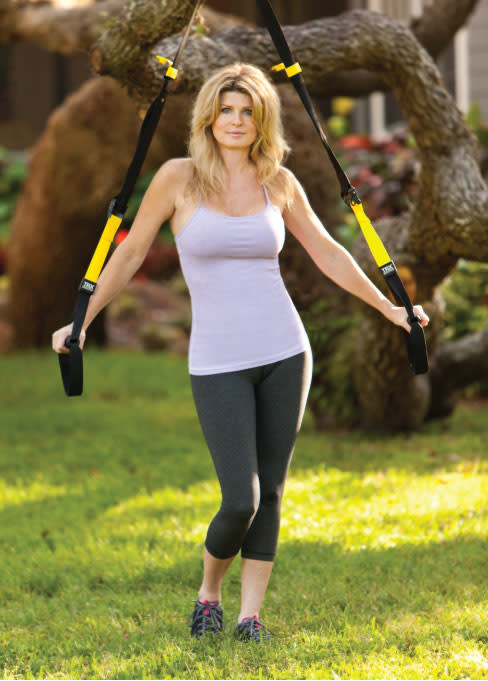
What: TRX training
Where: In my garage
The skinny: Founded by a Navy SEAL, TRX involves working with thick straps suspended from a ceiling beam. Every exercise works the core, even when you're working your arms, because there's balance involved. I do the 17-minute express workout: 14 to 15 exercises for 45 seconds each, with five seconds in between to change the straps. You're really moving.
How long: Three years
How it's changed me: It keeps me toned without building bulk.
Kyla Weiner
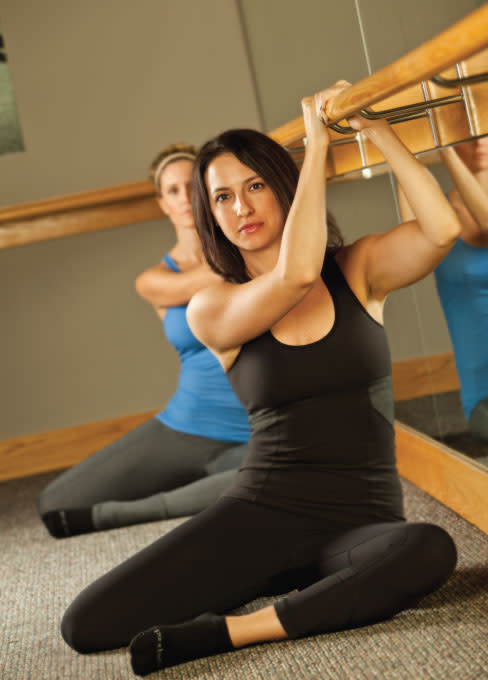
What: Pure Barre
Where: 3800 S. Tamiami Trail, Unit 16, Sarasota; purebarre.com
The skinny: A fusion of floor Pilates, ballet and yoga. You work in small isometric movements, and every class is a little different. It's so much fun and they do it to awesome music. I go twice a week and alternate it with cardio circuit and spinning classes.
How long: I took their very first class the day they opened last June.
How it's changed me: It's lengthened my muscles, slimmed down my thighs and given me flexibility and strength. My daughter turned two in November, and I'm below my pre-pregnancy weight.
